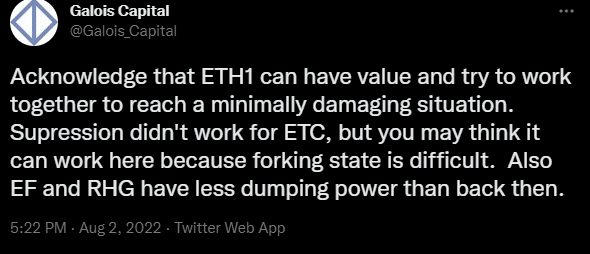
The best Ethereum update in history is on its way. The Ethereum Merge converts Ethereum’s blockchain from Proof-of-Work to Proof-of-Stake. The modification will hasten and reduce the cost of the leading blockchain for dApps and smart contracts. Furthermore, Ether has increased 52 percent in the past 30 days due to happy investors. However, some investors are dissatisfied with the system’s upcoming upgrade. As Ethereum finalizes its preparations for the Merge, the major cryptocurrency miners attempt to launch a campaign opposing the network’s much-touted switch to proof of stake.
Ethereum Merge – What’s Threatening Fork?
Some ardent miners are experiencing the depreciation of billions of dollars in mining technology and a drop in revenue. They threaten to keep the initial Proof-of-Work Ethereum network running to safeguard their investment.
To resist the update, they might break off and build their PoW versions of Ethereum. Before the chain merge, the branched networks would have the same wallet holdings and transaction history as Ethereum.
A movement to fork the Ethereum blockchain and establish a new, proof-of-work version has begun, according to a tweet posted on July 31 by Chandler Guo, a well-known Chinese cryptocurrency miner. Some passionate miners are experiencing a decline in revenue and the obsolescence of mining equipment, costing billions of dollars. As a result, they have threatened to continue running the Ethereum network’s initial Proof-of-Work to protect their financial investment.
In a protest, they threatened to split off and develop their PoW versions of Ethereum after the implementation update. The forked networks’ transaction histories and wallet balances would be identical to those of Ethereum before the chain merge.
According to Galois Capital, a social media influencer, the Ethereum community must recognize the potential utility of a Proof-of-Work fork and work together to achieve the least risky situation.
Skeptical of Post-merge Ethereum Forks’ Long-term Viability
Guo supports forking Ethereum, but he also pointed out that developers and protocols will most likely continue to prefer PoS Ethereum, posing significant challenges for newly forked networks. Justin Drake, an Ethereum Foundation researcher, raised the issue of PoW forks. Drake claimed that due to the prominence of wrapped assets and tokens held in DeFi protocols, a situation where both sides of the fork live is no longer realistic in our day and age.
He recognized that at least one person on the planet would attempt to continue the PoW chain. Drake recently stated on the Defiant Podcast that Merge has the support of key wrapped asset suppliers. As a result, one side of the Fork is safe and has a strong DeFi ecosystem, whereas the other side has a DeFi ecosystem that will completely collapse.
DeFi Breakage
According to Bob Summerwill, executive director of ETCCooperative, an institution that provides funding and support to the Ethereum Classic () ecosystem, PoW Ethereum forks will eventually fall amid the network effects of stablecoins and DeFi. Summerwill believes that any newly forked chain will experience widespread “DeFi breakdown.”
All the dApp websites will stop working because they will reference ETH, not the fork,” he said. “Even if it’s possible for somebody to bring up clone websites, servers, etc, that needs doing for every dApp, and then somebody needs to maintain all those forks, too. Some likely not even possible, because you would need admin keys to be able to operate them, and those belong to the existing operators.
Ethereum Services Contentious Fork
In its history, Ethereum has already weathered one acrimonious fork. On July 20, 2016, Ethereum Classic was founded in response to the Ethereum Foundation forking Ethereum to erase the theft of 3.64M Ether taken from The DAO, which amounted to around 5% of Ethereum’s circulating supply at the time.
The DAO consisted of an investor-directed venture capital fund and was one of the first experiments in decentralized autonomous organizations. DAO raised $150 million through a token sale in April 2016. In June, however, hackers stole nearly one-third of the funds. Users that objected to the following fork that neutralized the theft kept the old and unaltered Ethereum blockchain, resulting in the creation of Ethereum Classic.
Related
Battle Infinity - New Metaverse Game
- Listed on PancakeSwap and LBank - battleinfinity.io
- Fantasy Sports Themed Games
- Play to Earn Utility - IBAT Rewards Token
- Powered By Unreal Engine
- Solid Proof Audited, CoinSniper Verified

